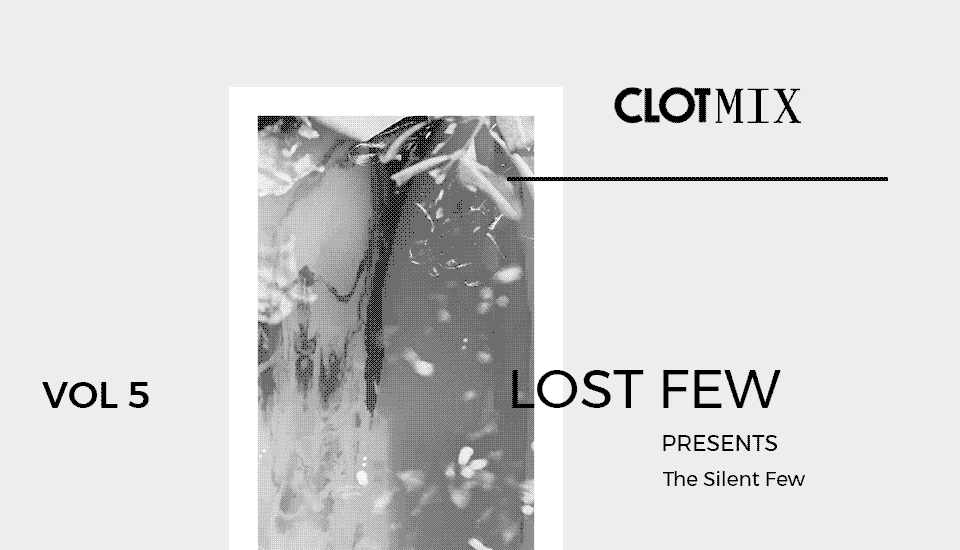Text by CLOT Magazine

The 5th volume of our Mixtape series comes by Lost Few, the audio-visual project of Melbourne-based experimental artist David Thomson. This mix is a personal journey developing a sense of space and theme that reflects the contexts and emotions he tries and explores with his work.
Lost Few has just published his debut LP, Between The Silence (Southern Lights 2019). The album mixes ambient techno, disturbed electronics, processed instrumentation & sub-bass experiments, leading the listener to a journey that traverses a world with a sharp, dissonant edge. And it also portrays the artist’s relationship with the physical form, which includes sound recordings from the Buchan Caves in Victoria and the Tasmanian wilderness.
For this mix, the selection of tracks comes from artists who have influenced Thomson or represent a sound and thematic that he relates to and engages with: While writing a new body of work I try to limit the music I listen to and separate myself from any external musical influences. I also stopped dj’ing when I started writing this album for that reason. However, you will still hear influences come through – for example I used to work at a job that was slowly destroying any creative output – I’d be on the train looking out the window as the sun rose above the roofs of the inner city suburbs with Roly Porter or Puce Mary slamming my ears – a cathartic and ritualistic experience.
Could you tell us a bit more about the conceptual process behind the inception of your debut album, Between The Silence?
The album is born out of a 16-channel ambisonic installation I did of a cave system I recorded between 2014 and 2015. Each song has elements of the recordings so that the central thread of the album is the cave environment. Our environment influences us and our behaviour, be it the beauty or brutality of natural or urban landscapes. Sound is physical, so I use that soundscape as a starting point to inspire and build a physical space that reflects the emotional and physical response I’m seeking. For me, my music is about recreating the soundscapes and spaces for the listener to inhabit for that period of time.
Another example is the first song I recorded rain on a Cymbal, through a contact mic which gives a really interesting rhythm and sound, which became the starting point for the song’s rhythm.
What is your relationship with novel musical technology nowadays? What use do you make of it for your compositions?
When writing a body of work, I seek to set technical limitations on my process to force interesting solutions and continuity with each song. So for this album, I kept the same set-up of equipment and Ableton templates.
The main focus is Physical Modelling, either my modular system based around MI Elements or Soft Synth Kaivo. I try and find interesting textures, then destroy them with effects. I love working with spatial audio tools and pushing the stereo field as much as possible to recreate and build my own space. For this album, each song had multiple Haas delays running. A favourite tool is sending the field recordings to a gated Haas delay side-chained to percussion. It gives all sorts of wonderful results.
To take the idea of spatial performance further, I recently undertook a 2-week residency at Berlin’s Centre for spatial sound MONOM. Working with 57 speakers built by 4D sound, I re-interpreted my album into a full spatial audio performance, taking the ideas behind the album and pushing them as far as possible. For me, my music is best heard in this sort of environment. When you can take away all senses except sound and fully envelop the listener in your composition, you can develop a unique ritual that pushes the audience into a liminal experience. You can begin to explore certain emotions inside a physical environment you have created through sound.
You are also a visual artist. What have you prepared for Between the silence?
For me, visual and sound art go hand in hand, an intrinsic relationship with each inspiring the other. For Between The Silence, I engaged collaborator and visual Artist Keith Deverell to help realise the live show. We built the performance around a music video with 3 sections of a redwood forest in the Yarra Valley with a lone female walking between the plantations. The physical nature of the clips created context and grounding for the audience to enter into a visceral experience that explores the relationship between natural environments, aggression and violence. Most of my visual works look to nature for inspiration.
For the cover art, I worked with visual artist Acid Hazel. I love collaborating with other artists as it brings new perspectives to the work. She is a mixed-media artist who creates collages using a variety of materials, including natural elements. For the performance at MONOM at I also collaborated with scent artist Maya from Garden State Candles to develop an individual scent with the Cave system being an inspiration.






